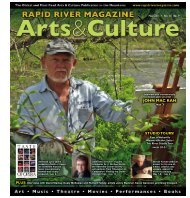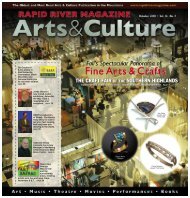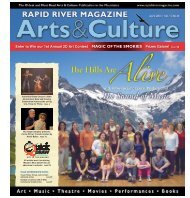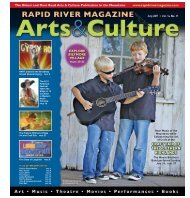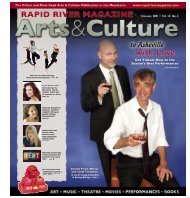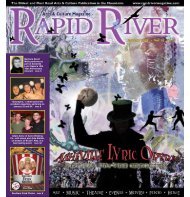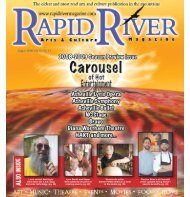winners of our annual poetry contest - Rapid River Magazine
winners of our annual poetry contest - Rapid River Magazine
winners of our annual poetry contest - Rapid River Magazine
Create successful ePaper yourself
Turn your PDF publications into a flip-book with our unique Google optimized e-Paper software.
R A P I D R I V E R A R T S<br />
fine art<br />
STUDIO<br />
SAFETY<br />
PART III<br />
Disaster Preparedness is<br />
Essential (D.P.I.E.)<br />
And even if it’s not fun, it doesn’t have to be painful.<br />
When I was a t<strong>our</strong> guide for the<br />
Denver Art Museum (DAM)<br />
a couple lifetimes ago, I used<br />
to work the environmental<br />
control boxes into my ramble.<br />
“Mid-20 th century mixed-media sculptural<br />
installation,” I would say. Invariably, one or<br />
two people would lean in and read the title:<br />
“Do Not Touch.” It was an opportunity<br />
to talk about the more complete museum<br />
experience <strong>of</strong> what<br />
is needed to preserve<br />
and protect the art.<br />
I was way <strong>of</strong>f-script<br />
since these were not<br />
technically “masterworks<br />
in the permanent<br />
collection.” But<br />
I think those little<br />
instruments were<br />
brilliant.<br />
Wouldn’t it be<br />
great if artists and<br />
their studios — and<br />
all <strong>of</strong> the amazing<br />
art put forth into the<br />
world — had monitors<br />
to keep it all safe?<br />
Unfortunately, this<br />
isn’t the case. And,<br />
really, how cumbersome<br />
would the equipment be?! But “the<br />
good news is” (a phrase I’ve adopted from<br />
Constance) that the basics for <strong>our</strong> safety<br />
DO exist, and for broader topics there are<br />
res<strong>our</strong>ces to help us along the way.<br />
Fire alarms, sprinklers and safety exits<br />
are typical systems in place to augment <strong>our</strong><br />
extinguishers, surge protectors, eye shields<br />
and first-aid kits. Add to that <strong>our</strong> watchful<br />
oversight regarding T.T.G.H.’s (“Things<br />
That Get Hot”), knowing where gas, electric<br />
and water shut-<strong>of</strong>fs are located and having<br />
proper insurance, and we are already quite<br />
prepared.<br />
For broader topics, I can also rely upon<br />
my new “Studio Protector, The Artist’s<br />
Guide to Emergencies,” which I recently<br />
mail-ordered from www.craftemergency.<br />
org. This is a comprehensive product produced<br />
by the Craft Emergency Relief Fund<br />
(CERF) and Artists’ Emergency Res<strong>our</strong>ces,<br />
with several funding partners. Designed to<br />
“Reduce The Impact <strong>of</strong> Disaster”, it is large,<br />
easy-to-read, colorful and wall-mountable.<br />
It contains two rotating info-wheels, an<br />
emergency contact booklet and f<strong>our</strong> miniguides<br />
on different topics, from pre-disaster<br />
to salvage. It folds out. Things are tuckedin.<br />
You get to spin stuff. It’s FUN!<br />
Because CERF’s non-pr<strong>of</strong>it mission is<br />
to support artists through both preparedness<br />
and support, this is a great res<strong>our</strong>ce for one<br />
Photo: Greg Vineyard<br />
BY GREG VINEYARD<br />
to anticipate the worst, and then navigate a<br />
crisis as smoothly as possible. For backup,<br />
it advises the use <strong>of</strong> SOL’s (Safe Off-site<br />
Locations — as you may have guessed, using<br />
initialisms is a hit with me!), and having a<br />
“Disaster Buddy.” Being in a community<br />
<strong>of</strong> artists myself, I know the grateful feeling<br />
<strong>of</strong> someone coming<br />
to the rescue to help<br />
with … whatever<br />
comes up. Like the<br />
French Broad <strong>River</strong>,<br />
for example. This<br />
concept works with<br />
neighbors, too.<br />
During the December<br />
2009 storm and<br />
power-outage, a<br />
cup <strong>of</strong> c<strong>of</strong>fee from<br />
the wood-burning<br />
stovetop next door<br />
was a priceless gift!<br />
Anyway, one<br />
can never be too prepared.<br />
Or too careful.<br />
The insurance<br />
industry knows that<br />
a majority <strong>of</strong> accidents<br />
occur in <strong>our</strong> comfort zones, where we<br />
may pay less attention. More car accidents<br />
happen close to home, and more folks fall<br />
down their OWN stairs more than when<br />
in an unfamiliar place and paying better<br />
attention. Being naturally graceful — imagine<br />
a gazelle — I can’t relate. Oh, wait, I’ve<br />
already revealed way too much in Parts I<br />
and II for you to believe me… OK, I’m the<br />
guy who trips over nothing and everybody<br />
turns to look. Sigh.<br />
Becoming informed, taking action and<br />
staying vigilant about studio safety issues<br />
both large and small can yield some serious<br />
P.O.M. (“Peace-Of-Mind”), clearing the<br />
way for the flow <strong>of</strong> art.<br />
Concluding next month…<br />
Greg Vineyard is a visual<br />
artist and creative consultant<br />
in Asheville’s <strong>River</strong><br />
Arts District. His hand<br />
thrown ceramics will be<br />
on display as part <strong>of</strong> the<br />
CURVEilinear exhibit at Gallery 86.<br />
See his Ceramics for Contemplation<br />
and Connectivity at Constance Williams<br />
Studio & Gallery, 12 <strong>River</strong>side Drive.<br />
Open 11 a.m. to 4 p.m. Visit the website<br />
at www.riverdistrictartists.com.<br />
34 February 2010 — RAPID RIVER ARTS & CULTURE MAGAZINE — Vol. 13, No. 6





